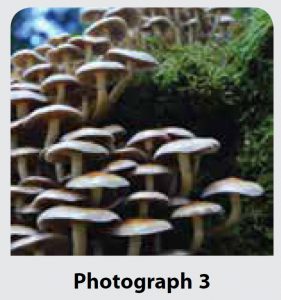
Photograph 3 shows a type of fungus on a tree trunk.
(a) Fungi were previously known as a plant. However, the fungus is now considered to be closer to the animals than to plants. Why are fungi classified into a separate kingdom and not into Plantae or Animalia?
(b) Predict what would happen in our environment if there are no fungi.
Answer:
(a)
Fungi have cell walls like plant cells, but the cell wall is made of chitin instead of cellulose. Fungi are not autotroph or photosynthetic because they do not contain chlorophyll. Fungi are not holozoic like animals which eat complex food. Fungi are parasites or saprophytes which digest food outside the hyphae. As the fungi is not autotrophic or holozoic, it is places in a kingdom separate from Plantae and Animalia.
(b)
Without fungi, the decomposition process does not occur. Organic matter will die and their bodies will crowd the environment. Important nutrients in the dead organisms are not returned to the soil to be reused by plants. Plants will suffer from nutrient deficiency.
Describe how nitrogen in the atmosphere can become a part of the animal and plant tissues, then return to the atmosphere in the form of nitrogen gas.
Answer:
• Plants and animals require nitrogen to build protein. However, both plants and animals cannot absorb nitrogen directly from the atmosphere.
• Nitrogen-fixing bacteria that live in the root nodules of legumes like Rhizobium sp. and free-living nitrogen-fixing bacteria in the soil such as Azotobacter sp. fixes the nitrogen from the atmosphere and changes it to ammonium ions (NH4+) via ammonification.
• Lightning in a thunderstorm oxidises nitrogen to nitrogen dioxide which dissolves in rainwater to form nitrous acid and nitric acid. Both form nitrate in the soil.
• Industrial fertilisers provide ammonium fertilisers and nitrates in the soil.
• When plants and animals die, decomposition is carried out by decomposers such as bacteria and saprophytic fungi. Protein in body tissue will be broken down into ammonium ions (NH4+).
• Ammonium ions are converted into nitrite ions via nitrification by the nitrification bacteria Nitrosomonas sp.
• Nitrite ions will be converted to nitrate ions by the nitrification bacteria Nitrobacter sp.
• The nitrates will then be absorbed by plant roots and used to synthesised proteins. When the plants are eaten by animals, nitrogen gets transferred to animal tissue.
• Denitrifying bacteria converts nitrates in the soil into nitrogen gas through the denitrification process.
You have been given a task to classify the organisms found in the herbaceous garden in your school. Describe the method you will use for this task.
Answer:
• One way to classify organisms found in the herbaceous garden in school is to use a dichotomous key.
• A dichotomous key is a tool to identify organisms based on a pair of discerning characteristics.
• The steps are as follows:
– Observe the main physical characteristics of a group of organism so it can be divided into two groups.
– In each group, find one or more characteristics that can further divide the group of organisms into two smaller groups.
– Repeat this over and over again until you arrive at one final organism.
– The characteristic used must be obvious and easy to observe.
– The classification into two groups must be based on opposite traits.
– The terms used must be clear.